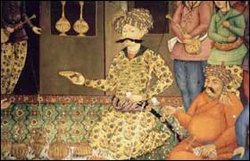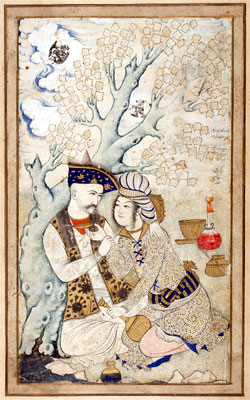Abbas I of Safavid
|
|
Shah_Abbas_I_engraving_by_Dominicus_Custos_-_Antwerp_artist_printer_and_engraver.jpg
Copper engraving by Dominicus Custos, from his Atrium heroicum Caesarum pub. 1600-1602
Shah Abbas I (شاه عباس اول) (January 27, 1571?-January 19, 1629?) was the most eminent ruler of the Safavid Dynasty. He was also known as Shah Abbas the Great (شاه عباس بزرگ). In early October, 1588 he became Shah of Iran, by revolting against his father, Mohammad of Safavid, and imprisoning him.
In the midst of general anarchy in Persia, he was proclaimed ruler of Khorasan in 1581, and obtained possession of the Persian throne with the help of Morshed Gholi Ostajlou, whom he later killed in July, 1589. Determined to raise the fallen fortunes of his country, he first directed his efforts against the predatory Uzbeks, who occupied and harassed Khorasan. After a long and severe struggle, he regained Mashhad, defeated them in a great battle near Herat in 1597, and drove them out of his dominions.
He moved his capital from Qazvin to Isfahan in 1592. A few years later, in 1599, the Englishman Sir Robert Shirley directed a major army reform. With his new army, he defeated the Ottoman Turks in 1603, forcing them to give back the territory they had seized, including Baghdad. In 1605 following a victory at Basra he extended his empire beyond the Euphrates; Sultan Ahmed I was forced to cede Shirvan and Kurdistan in 1611; the united armies of the Turks and Tatars were completely defeated near Sultanieh in 1618, and Abbas made peace on very favourable terms; and on the Turks renewing the war, Baghdad fell into his hands after a year's siege in 1623. In 1622 he took the island of Hormus from the Portuguese, by the assistance of the British, and much of its trade was diverted to the town of Bandar Abbas which he had taken from the Portuguese in 1615 and had named after himself.
Shah Abbas' reign, with its military successes, efficient administrative system, raised Iran to the status of a great power. Abbas was a skilled diplomat, tolerant of his Christian subjects in Armenia. He sent Shirley to Italy, Spain and England in order to create a pact against the Ottomans.
Trade with the west and industry grew. Isfahan became the center of Safavid architectural achievement, with the mosques Masjed-e Shah and the Masjed-e Sheykh Lotfollah and other monuments like the Ali Qapu, the Chehel Sotoun palace, and the Meydan-e Shah. His painting ateliers (of the Isfahan school established under his patronage) created some of the finest art in modern Persian history, by such illustrious painters as Reza Abbasi, Mohammed Qasim and others. Despite the ascetic roots of the Safavid dynasty and the religious injunctions restricting the pleasures lawful to the faithful, the art of Shah Abbas' time denotes a certain relaxation of the strictures. Historian James Saslow interprets the portrait by Muhammad Qasim as showing that the Muslim taboo against wine, as well as that against male intimacy, "were more honored in the breach than in the observance." Contemporary European observers at the Shah's court reflected similarly on prevalent customs. Among them was Thomas Herbert, the nineteen year old secretary to the British amabassador, who later related that he saw "Ganymede boys in vests of gold, rich bespangled turbans, and choice sandals, their curled hair dangling about their shoulders, with rolling eyes and vermilion cheeks." See Homosexuality and Islam
When he died, his dominions reached from the Tigris to the Indus. His fame is tarnished, however, by numerous deeds of tyranny and cruelty, particularly against his own family. Afraid of a coup by his family (as he had done to his father), he locked them up in palaces in order to keep them without knowledge of the outside world. This resulted in weak successors. He killed his eldest son, Safi Mirza, and left his throne to his grandson.
Sources
- The Persian Encyclopedia's entries on "Abbas I of Safavid" and "Mohammad of Safavid"
- Iran Chamber (http://www.iranchamber.com/history/safavids/safavids.php)
- See also The Three Brothers, or Travels of Sir Anthony, Sir Robert Sherley, etc. (London, 1823); Sir C. R. Markham, General Sketch of the History of Persia (London, 1874).de: Abbas I. (Persien)


